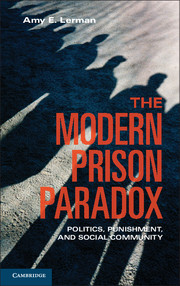Book contents
- Frontmatter
- Miscellaneous Frontmatter
- Contents
- Acknowledgments
- 1 The Modern Prison Paradox
- 2 Politics and the Punitive Turn
- 3 Public Policy and the Creation of Community
- 4 The Culture and Consequence of Prison
- 5 The Social Effects of Incarceration
- 6 The Social Effects of Prison Work
- 7 From Individuals to Communities
- 8 The Road to Reform
- 9 Epilogue (Or: How I Went to Berkeley and Wound Up in Prison)
- Appendixes
- Notes
- Index
4 - The Culture and Consequence of Prison
Published online by Cambridge University Press: 05 June 2014
- Frontmatter
- Miscellaneous Frontmatter
- Contents
- Acknowledgments
- 1 The Modern Prison Paradox
- 2 Politics and the Punitive Turn
- 3 Public Policy and the Creation of Community
- 4 The Culture and Consequence of Prison
- 5 The Social Effects of Incarceration
- 6 The Social Effects of Prison Work
- 7 From Individuals to Communities
- 8 The Road to Reform
- 9 Epilogue (Or: How I Went to Berkeley and Wound Up in Prison)
- Appendixes
- Notes
- Index
Summary
Paranoia is an illness I contracted in institutions.
It is not the reason for my sentences to reform school and prison.
It is the effect, not the cause.
Jack Henry Abbott, In the Belly of the Beast (1981)In the previous chapters, I have provided a wide-ranging overview of the changing landscape of corrections in the United States. This is important, I have argued, because variation in the culture of institutions can play a significant role in shaping the way individuals interact, both within and beyond the prison walls. In the remainder of this book, I turn from this broad historical and theoretical background toward a narrower empirical investigation of the book’s central premise.
My aim in this chapter is twofold. First, I outline the case of California corrections. In the United States, nearly half of all prisoners are released to just five states, and California alone accounts for about a quarter of all people released from prison. As in the nation as a whole, California’s incarceration rates steadily increased over past decades, with the number of prison inmates growing from 22,632 in 1979 to 168,350 as of 2006. In that year, there was about one state prison inmate for roughly every 168 adult Californians. Using three sources of data, in this chapter I examine the culture of California’s state prison institutions, with an emphasis on systematic variation in formal and informal dimensions of prison culture across different security levels.
- Type
- Chapter
- Information
- The Modern Prison ParadoxPolitics, Punishment, and Social Community, pp. 68 - 93Publisher: Cambridge University PressPrint publication year: 2013



